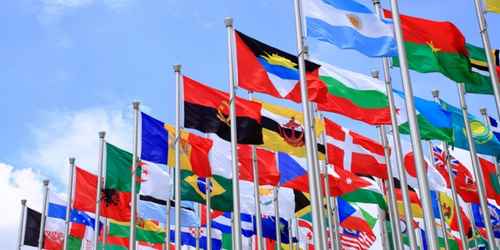The term “First World” was coined in 1952 by French demographer Alfred Sauvy and was widely used throughout the Cold War. Originally, the term was used to denote predominantly democratic/capitalist countries that were politically affiliated with NATO and the US. In comparison, “Second World” countries were largely communist countries that were politically affiliated with the Soviet Union. Finally, “Third World” countries were those that did not fall within either of the previous categories. However, the modern definition of “first world” has changed completely and in this article, we will carefully go into details of its new meaning and a list of first world countries to look out for this 2023. Let’s begin.
First World Definition
In historical terms, the term “first world” refers to the coalition of countries that allied with the US and NATO at the end of the Cold War. Following World War II, nations opposed to the Soviet Union and communism formed the Western Bloc, which the United States headed.
The meaning of the term “first world” shifted after the Cold War. Nowadays, a first-world country is defined as an industrialized or developed country with greater literacy rates, life expectancies, and GDP per capita than other countries. Mature economies and social welfare are important factors in determining which states are stable enough to be classified as first-world.
Historical Definition of “First World”
The term “first world” first appeared during the Cold War to describe countries that allied themselves with the North Atlantic Treaty Organization (NATO). Nations that supported the opposition, often known as the Warsaw Pact, were referred to as the “second world.” Countries that did not belong to a group were classified as “third world.”
As shown in the chart above, the “first world” historically consisted of the United States, Western Europe, and their allies. The “second world” was the Soviet Union, China, Cuba, and their supporters. South America, Africa, and the Middle East were all considered “third world” countries. Following the demise of the Soviet Union in 1991, the phrase “first world” was used to define wealthy nations in a new way.
Understanding the First World
The United States, Canada, Australia, New Zealand, and Japan are on the list of first world countries for 2023. Other Western European countries qualify as well, including the United Kingdom, France, Germany, Switzerland, and the Nordic countries.
The definition of first-world countries varies. A first-world country, for example, may be defined as being friendly or associated with Western countries or those in the Northern Hemisphere, highly industrialized, with a low poverty rate, and/or with easy access to contemporary resources and infrastructure.
First-world nations have been defined using a variety of criteria, including gross domestic product (GDP), gross national product (GNP), mortality rates, and literacy rates. The Human Development Index also indicates which countries are likely to be classified or appear on the top list as “first world countries.”
Economically, first-world countries have stable currencies and powerful financial markets, which makes them appealing to investors from all over the world. While not entirely capitalist, the economies of first-world countries are defined by free markets, private enterprise, and private ownership of property.
What are 1st, 2nd, and 3rd World Countries?
The world map is divided into three realms based on economic position, social programs, and political affiliation. Learn more about what distinguishes the various classifications:
#1. First world
Historically, countries opposed to communism were labeled as “first world.” Currently, the first world includes countries with larger GDPs, longer life expectancies, and stronger democracies than the second or third world. The list of these first world countries includes the United States, the United Kingdom, Japan, France, and, at the lower end of the scale, Greece.
#2. Second world
Second-world countries backed the Eastern Bloc and communism during the Cold War. They included the Soviet Union (modern-day Russia), China, and their allies, which included Cuba, North Korea, and Poland. Second-world countries now have weaker democratic ties and smaller GDPs than first-world countries. Poland, Hungary, Ethiopia, and Nicaragua are examples of modern second-world countries.
#3. Third world
In 1952, French historian Alfred Sauvy coined the term “third world” to refer to countries that were not affiliated with the United States and its allies. Currently, the word is contentious since it refers to impoverished countries, many of which are in Africa, that lack solid infrastructure and have greater rates of poverty, infant mortality, and illiteracy.
Criteria for “First World” Classification
According to the contemporary concept of the “first world,” countries in the classification are defined principally by political stability, economic stability, a high quality of life, and a capitalist economy. The following are some of the most common measures used to identify such countries:
#1. Human Development Index (HDI)
The Human Development Index (HDI) is a statistic produced by the United Nations to assess the economic and social progress of countries worldwide. The HDI has three dimensions: (1) a long and healthy life, (2) an education dimension, and (3) a standard of living dimension.
The HDI scale runs from 0 (very low degree of human development) to 1. (very high level of human development). Although there is no HDI cut-off for a country to be classified as “first world,” the higher the HDI, the more likely the subject country is included in the classification.
#2. Per Capita Gross Domestic Product (GDP)
Per capita GDP depicts the average economic output per person and is derived by dividing a country’s gross domestic product (available, among other places, on the World Bank website) by its population.
The per-capita GDP measure reflects an individual’s average standard of living and economic well-being. Although there is no cut-off for a country to be classified as “first world,” the higher the per capita gross domestic output, the more likely the country is classified as such.
#3. Literacy Rate (%)
The literacy rate is the percentage of people aged 15 and older who are skilled in reading and writing. A higher literacy rate is a better indicator of a country’s status as “first world.”
#4. Life Expectancy (Years)
The average age that a person is projected to live to from birth is referred to as life expectancy. A higher life expectancy provides a larger indication of a country with a robust healthcare system that is part of the “first world” classification.
Judging by these characteristics listed above, let’s take a look at the list of first world countries for 2023.
List of First World Countries 2023
These are some list of first world countries to look out for this 2023. They include:
| Country | HDI 2021 | 2023 Population |
|---|---|---|
| Switzerland | 0.962 | 8,796,669 |
| Norway | 0.961 | 5,474,360 |
| Iceland | 0.959 | 375,318 |
| Hong Kong | 0.952 | 7,491,609 |
| Australia | 0.951 | 26,439,111 |
| Denmark | 0.948 | 5,910,913 |
| Sweden | 0.947 | 10,612,086 |
| Ireland | 0.945 | 5,056,935 |
| Germany | 0.942 | 83,294,633 |
| Netherlands | 0.941 | 17,618,299 |
| Finland | 0.94 | 5,545,475 |
| Singapore | 0.939 | 6,014,723 |
| Belgium | 0.937 | 11,686,140 |
| New Zealand | 0.937 | 5,228,100 |
| Canada | 0.936 | 38,781,291 |
| Liechtenstein | 0.935 | 39,584 |
| Luxembourg | 0.93 | 654,768 |
| United Kingdom | 0.929 | 67,736,802 |
| Japan | 0.925 | 123,294,513 |
| South Korea | 0.925 | 51,784,059 |
| United States | 0.921 | 339,996,563 |
| Israel | 0.919 | 9,174,520 |
| Slovenia | 0.918 | 2,119,675 |
| Malta | 0.918 | 535,064 |
| Austria | 0.916 | 8,958,960 |
| United Arab Emirates | 0.911 | 9,516,871 |
| Spain | 0.905 | 47,519,628 |
| France | 0.903 | 64,756,584 |
| Cyprus | 0.896 | 1,260,138 |
| Italy | 0.895 | 58,870,762 |
| Estonia | 0.89 | 1,322,765 |
| Czech Republic | 0.889 | 10,495,295 |
| Greece | 0.887 | 10,341,277 |
| Poland | 0.876 | 41,026,067 |
| Saudi Arabia | 0.875 | 36,947,025 |
| Lithuania | 0.875 | 2,718,352 |
| Bahrain | 0.875 | 1,485,509 |
| Portugal | 0.866 | 10,247,605 |
| Latvia | 0.863 | 1,830,211 |
| Croatia | 0.858 | 4,008,617 |
| Andorra | 0.858 | 80,088 |
| Chile | 0.855 | 19,629,590 |
| Qatar | 0.855 | 2,716,391 |
| San Marino | 0.853 | 33,642 |
| Slovakia | 0.848 | 5,795,199 |
| Hungary | 0.846 | 10,156,239 |
| Argentina | 0.842 | 45,773,884 |
| Turkey | 0.838 | 85,816,199 |
| Montenegro | 0.832 | 626,485 |
| Kuwait | 0.831 | 4,310,108 |
| Russia | 0.829 | 144,444,359 |
| Brunei | 0.829 | 452,524 |
| Romania | 0.821 | 19,892,812 |
| Oman | 0.816 | 4,644,384 |
| Bahamas | 0.812 | 412,623 |
| Kazakhstan | 0.811 | 19,606,633 |
| Trinidad And Tobago | 0.81 | 1,534,937 |
| Costa Rica | 0.809 | 5,212,173 |
| Uruguay | 0.809 | 3,423,108 |
| Belarus | 0.808 | 9,498,238 |
| Panama | 0.805 | 4,468,087 |
| Malaysia | 0.803 | 34,308,525 |
| Serbia | 0.802 | 7,149,077 |
| Georgia | 0.802 | 3,728,282 |
| Mauritius | 0.802 | 1,300,557 |
| Thailand | 0.8 | 71,801,279 |
Criticism of the First World Designation
The use of the term “first world” to define democratic countries in comparison to developing nations and those with political regimes that do not correspond with Western nations is contentious. The expression is frequently used to place some nations above others in terms of geopolitical relevance. Such comparisons can produce schisms in international relations, especially when developing countries seek to negotiate with so-called first-world countries or seek international support for their concerns.
It is not commonplace for first-world countries to advocate for international policies, particularly economic laws, that benefit their industries and trade in order to protect or enhance their riches and stability. This can involve attempts to sway decisions made in institutions such as the United Nations or the World Trade Organization (WTO).
A country’s designation as a first-world country does not necessarily imply that it has local access to certain goods or resources that are in high demand. Oil production, for example, is a mainstay business in many countries that have historically not been considered first-world nations. Brazil, for example, supplies significant amounts of oil to global supply, as well as other forms of production; nonetheless, the country is seen as a developing, industrialized state rather than a first-world nation.
An Antiquated Model
There is a case to be made that the idea of classifying nations into first, second, and third worlds is ancient and outdated.
Since the Cold War’s end, the United States has emerged as one of the world’s superpowers, with an increasing number of countries adopting or in the process of embracing American-style democracy and capitalism. These countries are neither extremely poor nor extremely rich; the rule of law and democracy are their distinguishing characteristics. As a result, using the derogatory term “third world” to describe them would be paradoxical. Brazil and India are two examples of these countries.
The original definition of “first world” as a country linked with the United States has also resulted in some strange designations of extremely affluent and advanced countries. Even though oil-rich Saudi Arabia has a larger per capita income than first-world country Turkey, it is frequently classified as a second or third-world country, or refused the first-world label.
Then there’s the growing issue of wealth disparity. The high per capita income associated with the first world frequently conceals a very unequal distribution of wealth in these countries. Several first-world countries have impoverished regions with conditions equivalent to those found in underdeveloped countries. Residents in Appalachia and other rural parts of the United States, for example, frequently lack resources and necessities for a basic level of living.
Why is the Term ‘First World’ Contentious?
The term “first world” is problematic because it is out of date. It was first used during the Cold War to refer to countries that were allies of the United States—mostly other Westernized countries—as opposed to countries that were allies of the former Soviet Union. Because the economic measures used to define the first world differ depending on their perspective, the first world can be a hazy concept of a country’s economic standing. For example, despite having a per capita GDP nearly equivalent to that of Portugal, Saudi Arabia is frequently seen as a second-world country.
How many Countries are 1st World?
Countries having an HDI score of 0.800 or more are regarded to have “extremely high human development,” which is roughly equivalent to being in the First World. The most recent HDI rankings, including the 66 nations that qualified for the distinction in the 2020 report, will appear in the table further down on this page.
What are Considered 1st World Countries?
The term “first world” is now used to describe countries that are highly industrialized and have advanced economies. The United States, Canada, Japan, and Western European countries are on the top list of first-world countries this 2023.
Which African Countries are First World?
The top 10 list of the first world African countries this 2023 includes:
- Mauritius
- Seychelles
- Algeria
- Egypt
- Tunisia
- Libya
- South Africa
- Gabon
What are 3rd World Countries?
Third World countries. During the Cold War, the phrase “Third World” was established to designate states that were not allied with either the West (NATO) or the East (the Communist bloc). The word is now commonly used to refer to developing countries in Africa, Asia, South America, and Australia/Oceania.
What is a 2nd World Country?
The term “Second World” refers to the former communist-socialist, industrial states, as well as the Union of Soviet Socialist Republics’ territory and sphere of influence (Soviet Union). Communist Yugoslavia was the only country in Eastern Europe that was not allied with the Soviet Union.
The Bottom Line
First-world countries are those that are highly developed industrialized, technologically advanced, educated, and prosperous. In comparison to developing (second world) and less-developed (third world) countries, the first world is perceived to have numerous advantages, including a relatively high quality of life and affluence. During the Cold War, the term “first-world country” was used to designate developed countries that were thought to have the potential to influence international politics due to their economic, technological, and military prowess.
The word was not clearly political; rather than an ideological outlook, it described a gathering based on aggregate wealth or perceived power. Australia, Canada, France, Germany, Italy, Japan, New Zealand, Norway, the United Kingdom, and the United States were among the first-world countries represented. Currently, the word has fallen out of favor, with critics claiming it represents an outdated approach to understanding national growth.
Related Articles
- HIGH INCOME COUNTRIES: All About It and Full List of High-Income Countries
- COLD CALLING: Cold Calling Strategies 2023
- Top 5 Cold Calling Tips For Successful Sales
- The BEST 10 STATES TO START A BUSINESS in 2022 (Updated)
- EARNINGS PER SHARE EPS: Definition, Calculations, and Examples






